A Closer Look at … a Weddell Seal’s Eyes!
This journal is brought to you by:
- Mrs. Hillhouse and her 3rd grade CLUE students at Campus School
- Amy George and her 2nd grade CLUE students at Grahamwood Elementary
- Mrs. Gillespie and her 3rd grade SPARKS students at St. Ann School
- Mrs. Gillespie and her 4th grade SPARKS students at St. Ann School
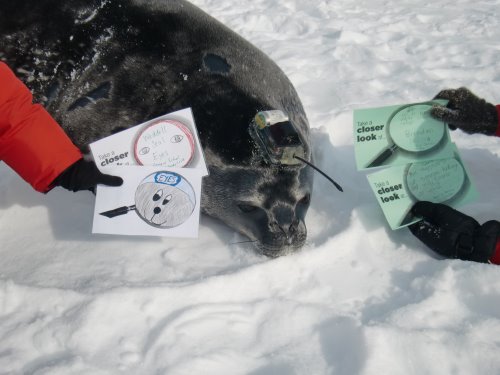
They wanted to take a 'Closer Look' at the Weddell seal eyes!
Look at those eyes!!!
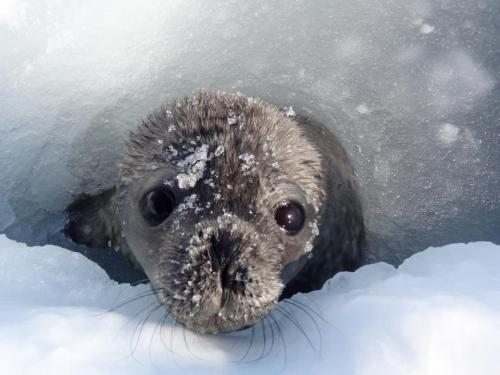
Aren’t they the biggest, brownest eyes you’ve ever seen in your life? I don’t know about you, but looking at this seal makes me wonder… how do I measure up? How much larger is a Weddell seal’s eye compared to mine? What do you think?
I did some research and here’s what I found. You didn’t think I was going to actually measure my own eye, did you?
An adult human eye is about 24 mm in diameter – which is about 1 inch, or 2/3 the size of a ping pong ball.
An adult Weddell seal’s eye is about 50 mm – twice as big!
Now, that’s pretty large, but do they work the same?
The Basics on How an Eye Works
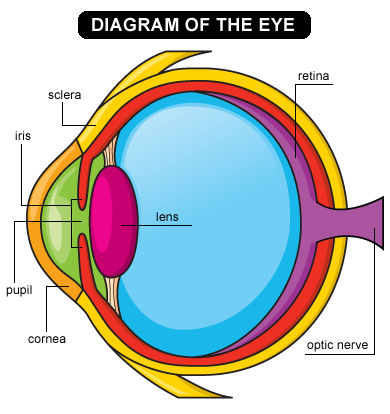
The eye is an organ that captures and detects light, like this:
- Light energy first passes through the cornea.
- The Cornea – clear, domed part of the eye – helps focus light rays toward the pupil.
- The Iris – colored part of the eye – controls how much light enters the eyes.
- The Pupil – which looks like a black circle – is the opening in the iris that allows light to pass through to the lens.
- The Lens focuses light energy to the ‘back of the eye’ or retina.
- The Retina has millions of light sensitive, or photoreceptor, cells called rods and cones. These cells take the light energy the eye receives and turn it into an electrical message. When these cells detect light, they transform it to a nervous signal that travels to the optic nerve and to the brain.
- Rods are the cells that ‘see’ the brightness, shape, and form of an image and can ‘see’ in black, white and shades of gray.
- Cones are the cells that ‘see’ details and color.
- The Optic Nerve carries the message to the brain, where it is processed.
Are you asking the same question I am? – If the basic parts of the eye are the same, what’s different about them?
Let’s look closer!
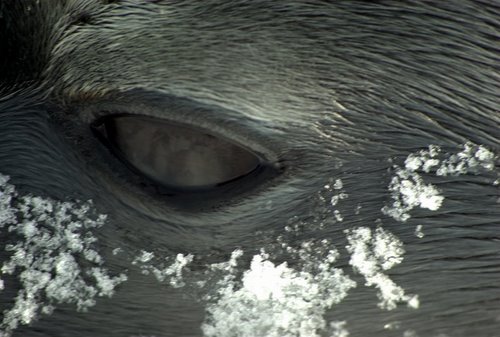
The iris, or colored part of the eye, is very large and very brown – you can’t see any white here – and it’s size is excellent for gathering light!
On land, the seal’s pupil is very difficult to see and looks like a thin slit (pinhole) – but underwater, the pupil becomes round – like ours – and lets in the maximum amount of light.
The biggest difference lies in the shape of the lens.
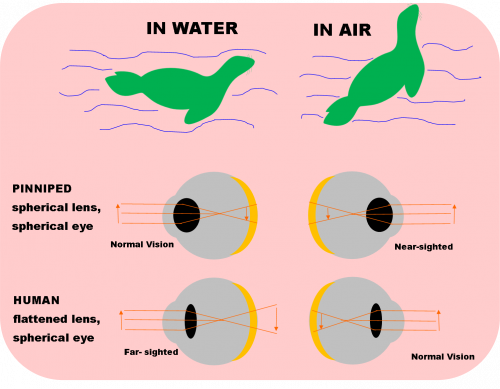
In both humans and seals, eyes are shaped like spheres, but the lenses are shaped differently. Seals have round lenses – humans more oval.
Why is this important? It has to do with how light is reflected. Animals, especially marine animals, which need to have good eyesight underwater, have round lenses. The rounder the lens is, the more the incoming light bends. Think about when you look through a glass filled with water… the image looks different – that’s from the light bending when it passes through the water. The same thing happens when seals see through water, but their round lenses bend the light in just the right way so the image focuses on the retina. They have perfect vision under water!
We land animals – who need to see through air – have lenses that are more flat because air does not bend light like water does. The result? We see well on land but not very well under water.
But seals need to see on land when they’re hauled out – how does that work? Well, even though the shape of seal lenses are not perfect for seeing through air, they aren’t that bad. In air, seals are a little near-sighted, which means they see things well as long as they are close.
Seals may be a bit color blind. The photoreceptor cells on the retina that ‘see’ color are called cones. Seals only have two sets of cones – humans have three. So seals may have a difficult time seeing a variety of colors but are most likely sensitive to the blues and greens of the ocean.
Seals are sensitive to light. The photoreceptor cells on the retina that ‘see’ different brightness are called rods. Seals have a large number of rods – an excellent adaptation for seeing in low light levels!
Behind a seal’s retina is a silvery, reflective layer called the tapetum. This lining helps to reflect more light onto the retina. How do you think this would help a seal in the dark, dimly lit depths of the ocean? If you said it would help to reflect more light onto the rods, helping them to see in low levels of light – then you are correct! Can you think of another animal that might have this tapetum?

Does it look like this seal is crying?

She’s not sad, this tear-like fluid is a protective mucus that covers the seal’s eyes. Some scientists think this fluid may help wash out bacteria from the ocean water.
Go Deeper!
The trick to understanding the difference between seal and human eyes is understanding how lenses work. We’ve already discussed how the shape of the lenses are different, but it’s also important to understand how the shape of the cornea changes the refractive index. The refractive index is the measure of the bending of light when it passes through a substance – like air or water. Both seals and humans have cornea that have a different refractive index than air – that means the light that comes into the eye from air is bent, and the cornea is shaped to correct the angle and focus the light. In seals, the refractive index of the cornea is similar to that of water, so the light that comes into the eye from water is not bent, which makes it easier for seals to see underwater.
From the scientist, Dr. Burns:
In humans, when light hits the cornea it is refracted (starts to bend) and then it is bent more when it hits our flattened lens. This allows incoming light to be focused on retina. When in water, the cornea (of humans or seals) does not cause the light to bend very much (very low refraction). And a flattened lens does not bend light as much as a spherical lens. Thus, the incoming light is not focused on the retina, but behind it; and so humans are farsighted when underwater, but normal sighted when on land.
Seals’ eyes have evolved a solution: their lenses are round (spherical), not flattened (oval). When underwater, this causes the incoming light (that has not been bent much by their cornea) to bend far enough that it is focused on the retina so that the seal has normal vision while underwater. However, when on land, the light is refracted some by the cornea (just like humans on land) and then a lot more by the round lens. This causes the light to bend too much, so when on land the seals are nearsighted.
Look back at the comparison diagram to help you understand!
In reference to the Weddell seal photos: The activity/animal depicted was conducted pursuant to NMFS Permit No 87-1851.


Comments